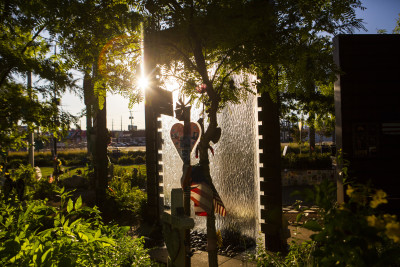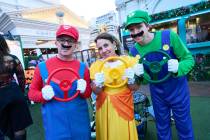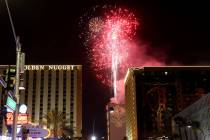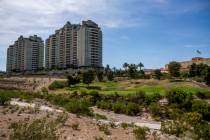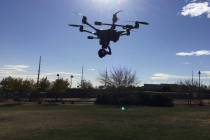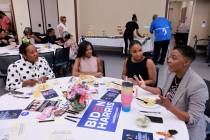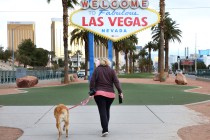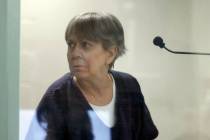How a community garden helped Las Vegas grow stronger
Beneath a canopy of green, Christopher Roybal smiles in perpetuity.
He looks happy in the picture hanging from a Tipuana tipu tree, one of 58, eyes bright as the sunny afternoons shaded here. The sailor served multiple tours of duty in Afghanistan.
“Shipmate you stand relieved … We have the watch!” reads a small, square, homemade memorial amid American flags and flower-adorned crosses.
When the shooting began Oct. 1, 2017, at the Route 91 Harvest music festival, Roybal’s military training kicked in. Though he had returned to civilian life by then, finding success as a gym manager, at 10:05 that night, he instantly became a warrior again.
A warrior right to the end.
Christopher Roybal lost his life helping others save theirs.
His mother joined him at the concert, along with some friends. Eight days later, Debby Allen returned to Las Vegas to collect her son’s body — on his birthday. He would have been 29.
Afterward, she came here, to this small, peaceful parcel of land in the Arts District, once barren, now thick with shrubs, flowers, hand-painted rocks — and memories.
Lots and lots of memories.
While here, she picked out a tree for her son — one of the first you encounter when walking into the Las Vegas Community Healing Garden from the parking lot nearby.
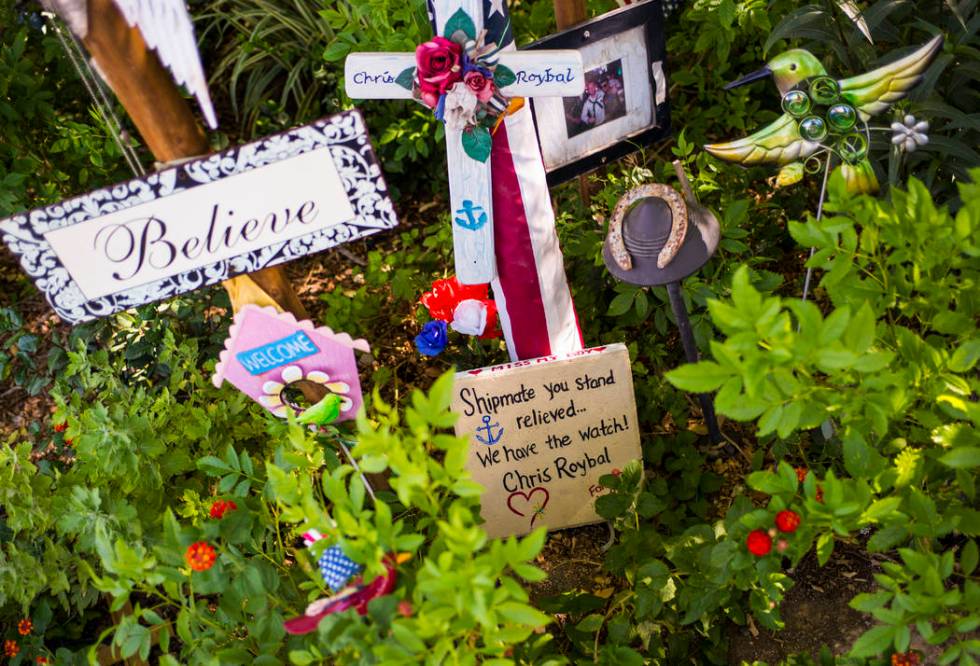
“He was such a center-of-attention kind of person that I made it be one of the trees in the front,” Allen says from her home in Corona, California.
Allen will be back here Tuesday to mark her son’s passing and all of the others lost during the music festival massacre. She’ll do so at a place of beauty begat by tragedy, in this living, growing, enduring symbol of thousands of hands working toward one goal.
Built in just four days, the Healing Garden was a remarkable feat chronicled in a new book, “Healing Las Vegas,” which also comes out Tuesday. It tells the story of a garden coming together, constructed by a community doing the same. But it’s not just a chronicle of this place being built, it’s the story of a city carrying on in the face of something that made carrying on hard to fathom at first.
This garden came from nowhere. Just like the tragedy from which it sprang.
Two years later, to come here is to be enveloped in lush, purposely overplanted life, and to breathe in a palpable sense of renewal. It literally fills your lungs. It’s the feeling of something lasting being born from something lost.
“Everyone remembers the victims the moment it happens, but oftentimes after tragedies, then they just get forgotten,” Allen says. “For me, keeping his memory alive is probably the most important thing. I think the Healing Garden represents what I want to represent, which is their life.
“Every time I go there, I meet different people,” she notes. “I get to tell my story. I guess that’s what I mean by keeping him alive.”
A gut reaction
It all began on the back of a coffee shop menu.
Jay Pleggenkuhle is sitting at downtown café PublicUs, struggling — sometimes unsuccessfully — to be heard above the plate-clanging bustle. He speaks in earnest tones befitting the open book of a man he is.
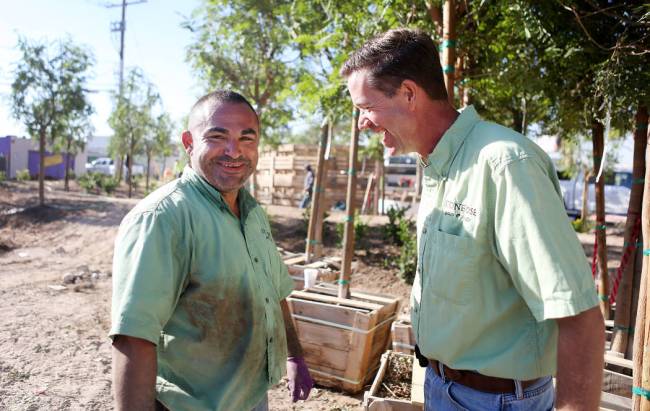
On the morning of Oct. 2 two years ago, the owner of Henderson’s Stonerose Landscapes met with his friend and co-worker Daniel Perez here, where the two hastily sketched out the initial design for the Healing Garden, with no paper or any real plan between them.
It was an emotional response to this visceral thing the whole city was attempting to process.
“I didn’t know anybody at the shooting,” Pleggenkuhle says, “but it was six miles from my door, and I have a son who goes to a lot of music festivals. He could have been there.
“When he came in my room on Sunday night and put that on the TV and said, ‘Look what’s going on’ and you heard that (mimics sound of gunfire) like it was some stupid movie, I mean… ,” he continues, pausing to collect his words while attempting to articulate something that was never about words.
It was about action.
“You know what?” he continues. “Anything we did to move forward was the right thing to move forward, right?”
But Pleggenkuhle didn’t really know what that “anything” was.
He just knew he had to do something.
And he had to do it now.
“We overthink so much — we just do as a society. We overthink, overplan,” Pleggenkuhle says. “This was just a gut reaction on a Monday morning, really. It was just like, ‘Where are people going to go and lay those piles of flowers? Where are they going to light candles? In a casino?’ ”
With that, Pleggenkuhle and Perez set out to provide them with such a place.
“We pushed back with a very deliberate act,” Pleggenkuhle says. “ ‘Hey, this happened, what are we going to do? We just going to stay sitting there? Or are we going to get out there and do something?’ ”
And so he made a phone call.
A timely call
He was like his little brother. And as big brothers do, Brad Jerbic busted his chops a little bit.
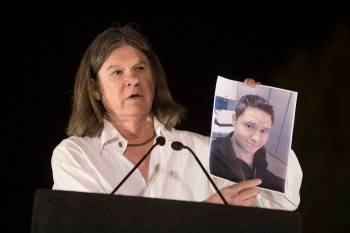
It was the Thursday before the Route 91 Harvest festival, and Las Vegas city attorney Jerbic was having some fun at the expense of his friend Cameron Robinson’s musical tastes.
Robinson, a management analyst with a bright future, had gotten his master’s degree the year before.
“He comes into my office and tells me he’s going to this country music festival,” Jerbic recalls. “I’m telling him how country music makes my ears bleed, and we’re joking back and forth. Sunday afternoon he sent me a picture with some other friends and they looked like they were having fun.
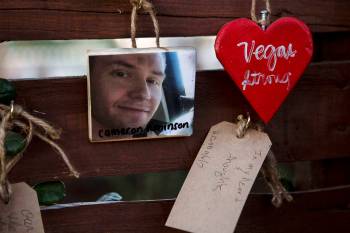
“The next morning, I turn on my TV at like 5 in the morning — I never get up that early; this morning I did — and it’s about the shooting in Las Vegas at the Harvest festival,” he continues. “And I thought, ‘What the hell’s a Harvest festival?’ Then I see the cowboy hats, and I realized it was the same event that Cameron was at.”
He called and texted Robinson but only got voicemail — no replies.
“At 7:15, the phone rang, and I learned that we lost Cameron,” Jerbic recalls. “As people trickled into the office, I told them. There was just a devastated office.”
One of Jerbic’s attorneys suggested that everyone go for a walk, get some fresh air — maybe that would help in the Sisyphean task of attempting to make sense of the senseless.
“I said, ‘I’d rather sit here than go out there and walk around,’ ” Jerbic remembers. “And that’s exactly the moment the telephone rang.”
It was Jay Pleggenkuhle.
No plans? No problem
Mavis Barnette doesn’t go down to the cemetery where her daughter is buried.
“I don’t feel that she’s there,” she says of Carrie Rae Barnette, a 34-year-old culinary worker at Disney California Adventure who died during the Route 91 festival.
Her remains rest in the family’s native California.
“She’s up there,” Barnette continues, speaking of the Healing Garden, which she last visited in January. “I feel more at peace that she’s there with the other people who she was enjoying something that she loved with. I feel more calm and consolation there than I do at the cemetery.”
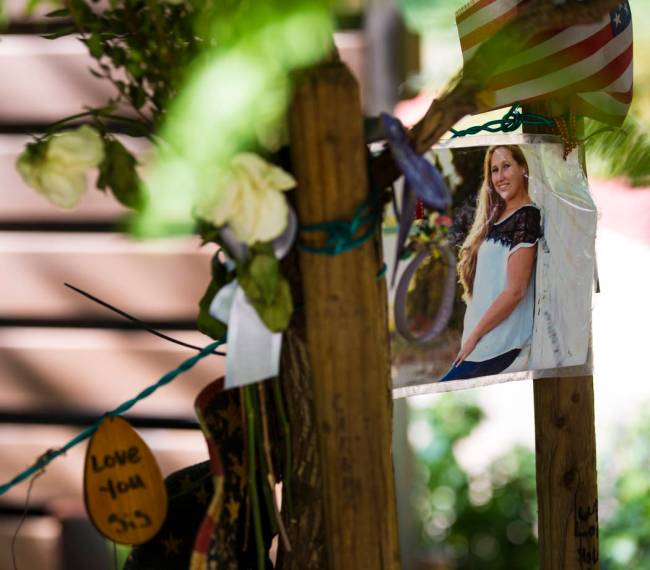
When he was devising the initial concept of the Healing Garden, Pleggenkuhle didn’t expect the end result to have this effect on people.
So when he called his friend Brad Jerbic on Oct. 2, looking for a spot to help people grieve, he never foresaw what was about to happen — and happen fast.
“We decided, ‘We’re not going to put it through plans check for any permitting requirement. Let’s get going,’ ” Jerbic says. “And that was it.’
Originally, Pleggenkuhle was seeking just an empty lot downtown for a vigil of some sort.
But on Tuesday morning, he got word that the city would donate land — as long as it was used for something enduring.
“I wanted to do a pop-up park,” Pleggenkuhle says. “I never imagined they’d say, ‘Hey, we’ll give you property if you make it permanent.’ ”
So, when could Pleggenkuhle have it completed? End of the week, he offered, in time for First Friday. And with that, the Garden was officially a go — in the span of 24 hours.
“That’s the first time I cried,” Pleggenkuhle acknowledges, “the first time I thought about it logically. It was like, ‘I don’t know where any plants are coming from yet. I don’t know if there’s people who will even show up. I don’t know.’ ”
So he started calling everyone he knew.
“Some people laughed at me — said, ‘You’re really not getting paid? What an idiot,’ ” he remembers. “But then some people were like, ‘We’re on board.’ ”
Moon Valley Nurseries donated the trees. Star Nursery starting bringing over trucks of shrubs. Apache Stone supplied the paving. Siegfried & Roy, longtime acquaintances of Pleggenkuhle, covered the expenses for the Tree of Life, the garden’s centerpiece.
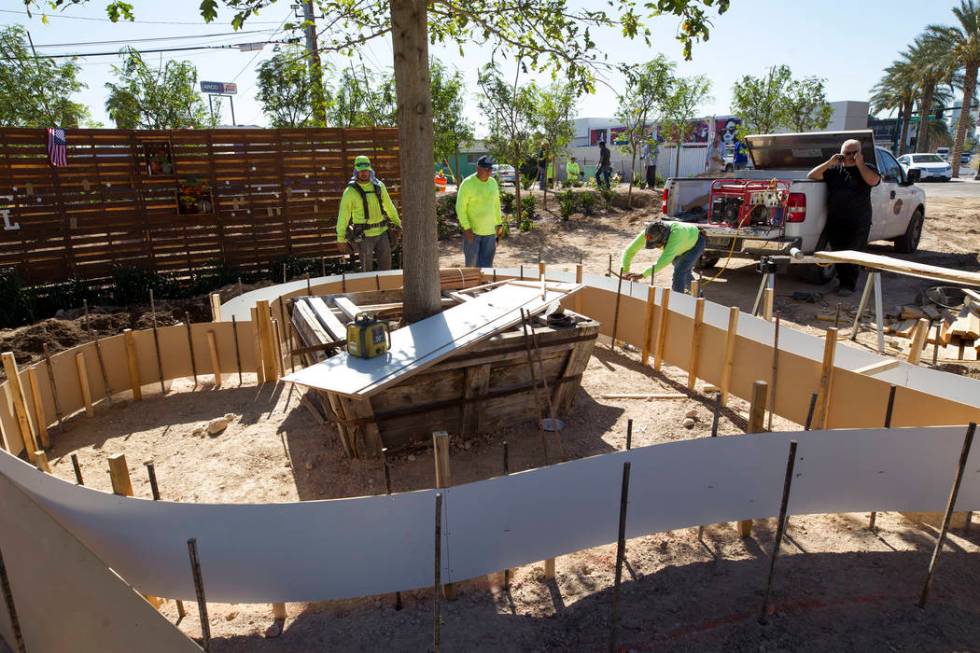
Pleggenkuhle even found a company willing to donate 1,500 tiles to adorn the cement heart that forms the base of the tree. The only catch? They were in Los Angeles. So he made yet another call to a friend.
“She texted back 20 minutes later, ‘Don’t think about this — it’s done. They’ll be there Friday,’ ” recalls Pleggenkuhle, with awe in his voice. “I mean, 1,500 porcelain tiles, that’s heavy. They blew the transmission on their truck. They had to junk their truck and buy a new one. But they got the tiles here.
“It’s crazy stuff like that that people were doing.” he continues. “It’s not logical. It’s not good business by any means. But they did it. And it made a difference.”
One cause, many hands
He got here at 7 a.m. and left 20 hours later.
Adoniram Ramos Vanegas gazes at one of the trees he planted on his marathon first day helping to build the garden.
It is Christopher Roybal’s.
“I come here as often as I can, just to make sure that everything is OK,” he says on a recent weekday morning. “We made a commitment to keep this going.”
A native of Nicaragua who works as a contractor for the city of Las Vegas, Vanegas was eager to help build the garden as soon as he learned about it.
“I got good hands,” he says.
He was one of many to lend their hands to the cause.
Once the city put out a call for volunteers on social media, the floodgates opened. It was a dam burst of people.
“It was pretty amazing,” Pleggenkuhle says. “I’m guessing there were three, four, five thousand people who came and volunteered over the period of those three days. It was so many people. There was no arguing, no fighting. Everyone was coming with their own thing, Jewish, Christian, whatever. There were monks there working.”
There was a broad outline for what the garden would look like: An elevated path would wind through 58 trees, with a memorial wall and the Tree of Life out front.
“I like the idea that when you’re on that pathway, even though there’s asphalt and an alleyway 15 feet away, you could be on top of Mount Charleston,” Pleggenkuhle says. “It’s as if you lifted up a piece of woods and set it there.”

When it came to determining what would be planted where, the process proved to be as organic as the garden itself.
“Have you ever seen one of those cooking shows where they give you this basket full of food and say, ‘We’re going to give you an hour, you’ve just got to do something with it?’ ” Pleggenkuhle asks. “We did have sort of a layout, but then in the end, it’s just where anyone set something, that became home. You look in nature, wherever the seed drops, it’s home. So it became that random, yet that perfect.”
Vanegas smiles, remembering how it all came to be.
“We worked together,” he says. “It doesn’t matter your nationality. It doesn’t matter your color. What matters is that we make it happen for Las Vegas. We have fun while doing it. We laugh. We figure out, ‘Hey, who’s got good hands.’ ”
And then they put them to good use.
‘It’s just like a magnet’
“There’s a Japanese term, ‘Wabi-sabi.’ Do you know it?” Pleggenkuhle asks. “ ‘Wabi-sabi’ is that beauty or perfection is found in the imperfection. That’s what this is,” he says, scanning the garden on a late August morning. “It’s not perfect. But it’s perfect for what we need.”
It’s just past 8:30 a.m. and already sticky hot, the sun as unrelenting as the water currently gushing from a broken sprinkler, soaking the grass out front. Pleggenkuhle makes a call to have it fixed. Though the city officially oversees the tending of the garden, Pleggenkuhle still comes here often to check on things.
The garden has grown in ways that he didn’t foresee, both physically, in terms of vegetation, but also in what it’s come to symbolize.
He began noticing this as it was being built, when Pleggenkuhle discovered that some volunteers came to lend a hand for reasons unrelated to the massacre.
“There was a guy there whose dad died in the MGM fire,” he says, referencing the 1980 blaze in which 85 people perished. “There was another guy who was there whose wife fell and hit her head and died, and he never quite got past that. The guy whose dad died in the MGM fire, he said, ‘There was no place to go to grieve together.’ ”
Now he had that place.
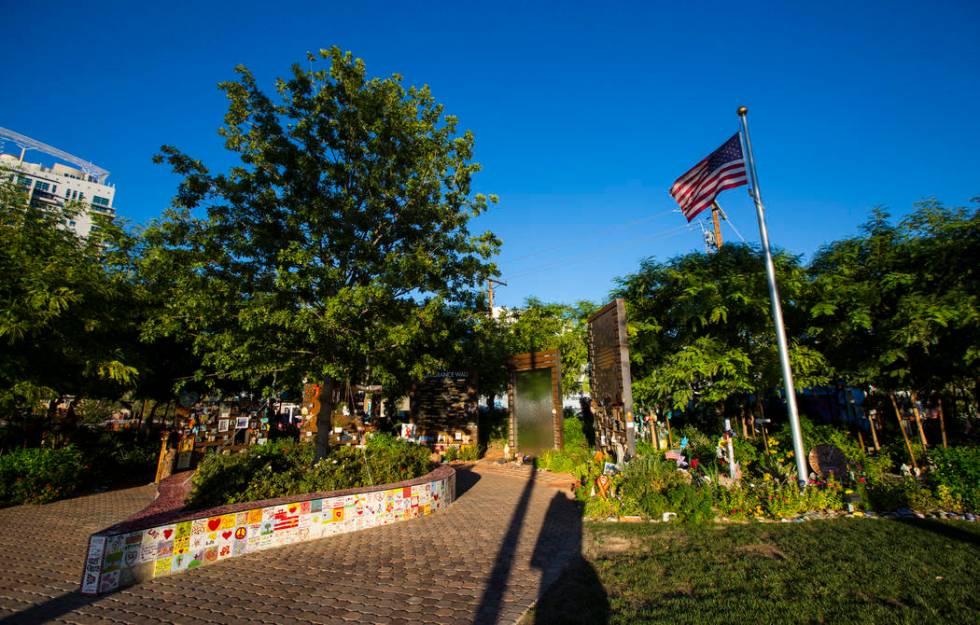
“People come that have no connection with anybody at that shooting that night or anything else,” Jerbic says. “It’s kind of become a place where, if you have no other place to go and there’s something that’s bothering you or you just want some tranquility or you just want to reflect — it’s just like a magnet.”
If there’s a mass shooting in another town, Jerbic now makes it a point to call the city attorney there to share what he and his staff learned in the aftermath of the festival tragedy.
“We didn’t know what to do when everything happened,” he says.
One of the things he recommends is for that city to start a healing garden of its own.
“I say, ‘If you guys can get one of these things going … it will pay dividends in your recovery and how you think of yourselves,’ ” he explains.
For some Route 91 survivors, like UNLV assistant hockey coach Nick Robone, the Healing Garden helps provide a conduit for looking back on those lost that night while simultaneously moving forward.
“My plan is to go there every October 1, and just kind of pay my respects to those people,” he says. “When I go there, I definitely have some mixed emotions. It brings up everything that went on that night. There’s definitely some sorrow.
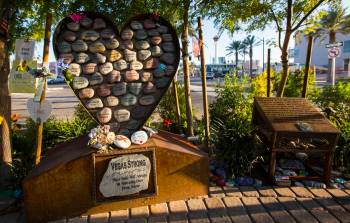
“But at the same time, it’s a reflective thing for me and how lucky I am to still be on this earth and in this community,” he adds. “It’s a bit of a reminder to cherish life, but moreso, I really want to go there and remember those people.”
Remembrance is on Pleggenkuhle’s mind as he eyes the path through the garden’s trees.
“That’s why there’s that walkway: You go through it,” he explains. “In life, things happen, and you go through them. You lose a loved one, you go through that. You don’t get to go around it. That’s the whole point of this. It’s not ‘Stand back and just look at it.’ You walk through it to the other side, turn around and see things differently.
“That’s all this did,” he says. “Help people to start that. We just gave them something beautiful to go through.”
Then he gets back to work..
Life goes on.
Gardens grow.
Contact Jason Bracelin at jbracelin@reviewjournal.com or 702-383-0476. Follow @JasonBracelin on Twitter.



